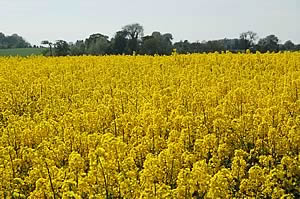 |
|||||||||
|
|||||||||||||||||||
Late
Growth Surge Puts Onus on Tip-Top OSR Desiccation The resurgence in oilseed rape growth following the May and June rains combined with noticeably earlier overall maturity this season means growers across the country will have to look to their laurels in the coming few weeks if they are to minimise harvesting problems, warns ProCam technical agronomist, Nick Myers. Especially so since there has also been a major recent surge in late thistle and other weed growth.
“As well as very late crop and weed growth, we’re seeing even more unevenness in crop maturity than usual this season as a result of stem canker together with surprisingly high levels of sclerotinia infection in many cases,” he points out. “Add this to the considerably larger acreages of the crop
many growers have in the ground this year, not to mention generally
thicker stems as a result of better canopy management, and harvesting
could be particularly troublesome for those that fail to get their
harvest management spot on.” “Don’t wait for your crops to look the colour of a hare’s back from the gate before you go in with the sprayer,” Nick Myers insists. “Get out there, open up a representative sample of pods and see whether they’ve reached the correct stage of maturity. “Otherwise you could easily find yourself getting well behind
the crop and suffering the increased shedding problems inevitable
with late harvesting as well as unnecessary delays in what is shaping-up
to be a particularly chancy harvest. “Given the thickness of many crop canopies I’d also strongly advise using 200-250 litres of water per hectare instead of just 100-150 litres and including include a water conditioner like Strada or XChange in the spray tank for greatest overall efficacy. “Even though Roundup Max works a good two days faster than
traditional glyphosates, you must leave the crop for the statutory
14 days before harvesting,” says Nick Myers. Roundup Max Desiccation Timing Check
|
|||||||||||||||||||

|
|
||||||||||||||||||
| home | agri-services | pedigree
pen | news | dairy | beef | machinery property | organisations | site map |
|||||||||||||||||||

